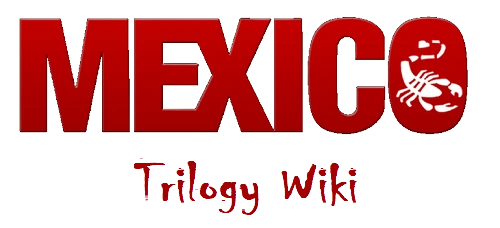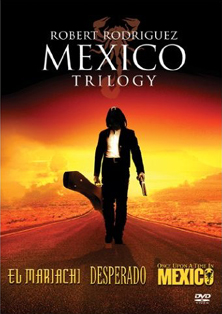The Mexico Trilogy or Mariachi Trilogy (also Desperado Trilogy on some DVD releases) is a series of films— El Mariachi, Desperado, and Once Upon a Time in Mexico —all written, produced and directed by Robert Rodriguez, beginning in 1992 and ending in 2003, and distributed by Columbia Tristar. The films tell the continuing story of the movies' main character, "El Mariachi".
Plots[]
A recurring theme of the Mexico Trilogy deals with El Mariachi being alone as all of his loved ones die in front of him.
El Mariachi tells the story of an out-of-work musician, known simply as El Mariachi (Carlos Gallardo), traveling through Mexico. He arrives in a small border town, hoping to find work in some of the local cantinas and clubs. Unfortunately for the man, local hoodlums mistake him for a recently-escaped convict who has been hunting down his former associates with a guitar case filled with weapons. As the story progresses, Mariachi falls in love with a woman who helps him hide from those who are trying to kill him, and eventually sees her die at the hands of those same men. He seeks revenge for all he has been put through.
Desperado continues El Mariachi's (now portrayed by Antonio Banderas) quest for revenge where he finds a new love and quenches his thirst for revenge.
Once Upon a Time in Mexico revolves around a failed coup attempt on the President of Mexico wherein El Mariachi is the hero who saves him. El Mariachi also seeks revenge on the murderer who killed his wife.
Origins[]
The trilogy was originally conceived as a way for Rodriguez to make three movies for the Spanish-language home video market to hone his skills as a director. Quentin Tarantino, a friend of Rodriguez, is reported to have said to Rodriguez that El Mariachi and Desperado were the start of his Dollars Trilogy, the trilogy of Western films directed by Sergio Leone consisting of A Fistful of Dollars, For a Few Dollars More, and The Good, the Bad and the Ugly. Rodriguez agreed on this idea, and the resulting conclusion of the trilogy, Once Upon a Time in Mexico, has many similarities with its Spaghetti Western counterpart. This is often the explanation of, and reason behind, the inclusion of much more screen-time and story centered around different characters other than El Mariachi within Once Upon a Time in Mexico.
Production[]
The trilogy began with the 1992 low-budget production of El Mariachi. The film was made on a budget of only US$7,000 using 16-millimeter film, was shot entirely in Mexico with a mostly amateur cast, and was originally intended to go directly to the Mexican home-video market (a process detailed in Rodriguez's book Rebel Without a Crew). Reportedly Rodriguez got some funds for the film by offering himself up as a human guinea pig to science labs. Other finances came in the form of prize money won by his short student film, Bedhead, at film festival competitions. Executives at Columbia Pictures liked the film so much that they bought the rights to it for American distribution and eventually spent several times more than the film's original production budget on 35 millimeter film transfers, a marketing campaign and the eventual distribution/release of the film. It was so well received that they eventually chose to finance the second part of the trilogy, Desperado, and subsequently the final chapter, Once Upon a Time in Mexico.

